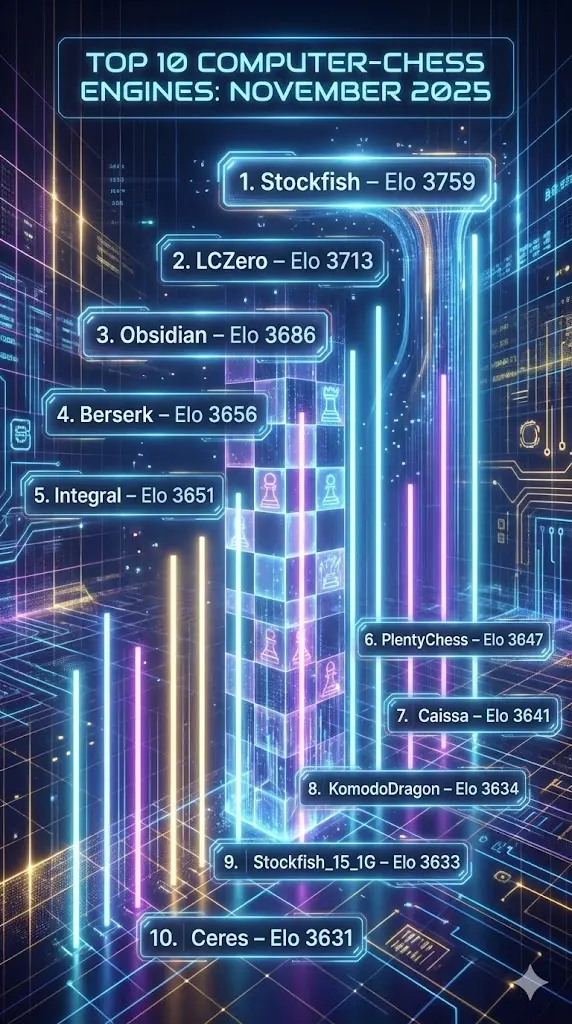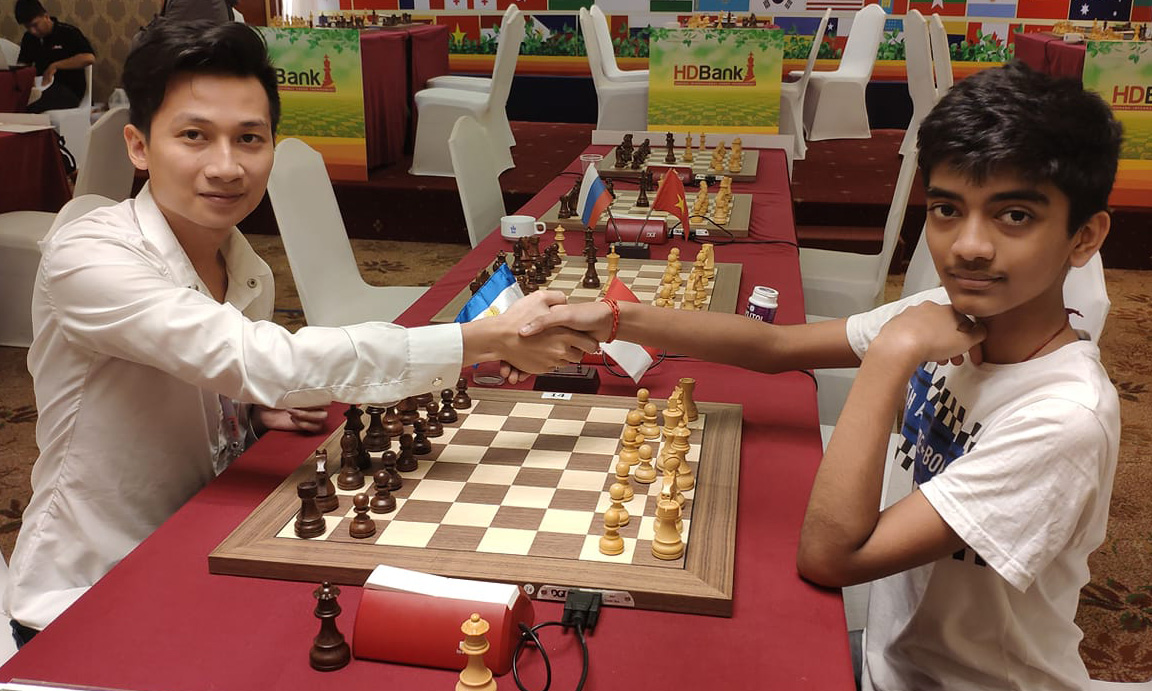When looking at the top tier of computer-chess prowess in November 2025, the field is dominated by engines whose strength now surpasses anything a human grandmaster could achieve. According to the TCEC listing, we have in order:
- Stockfish – Elo 3759
- LCZero – Elo 3713
- Obsidian – Elo 3686
- Berserk – Elo 3656
- Integral – Elo 3651
- PlentyChess – Elo 3647
- Caissa – Elo 3641
- KomodoDragon – Elo 3634
- Stockfish_15_1G – Elo 3633
- Ceres – Elo 3631
What follows is a closer look at each engine: how it fits into the landscape, what its background is, and what distinguishes it from the others.
1. Stockfish (Elo 3759)
Stockfish remains the benchmark for computer chess. It is open-source, widely used, and has a long record of dominance in the TCEC competition.
Its success is built on extremely efficient search algorithms (alpha-beta, huge move‐generation capability, tablebases) combined with neural network evaluation modules in more recent versions. Stockfish has repeatedly outperformed all rivals in head-to-head Superfinals.
At Elo 3759 it occupies a clear lead over even the second engine, signalling that at this moment it is the most refined, battle-tested engine in the world.
2. LCZero (Elo 3713)
LCZero (short for Leela Chess Zero) represents a different paradigm: a deep-neural-network based engine that learns from self-play rather than relying primarily on handcrafted evaluation functions.
LCZero’s strength comes from its ability to recognize long‐term positional patterns, pawn structure subtleties, and strategic themes in a more “human‐like” way, unlike purely brute‐search engines. This gives it a unique playing style and makes it a formidable adversary.
At Elo 3713 it sits just behind Stockfish, demonstrating that the neural‐network paradigm is fully competitive at the highest level.
3. Obsidian (Elo 3686)
Obsidian is a more recent entrant to the very top of engine rankings but has climbed rapidly. Its author is a young developer, Gabriele Lombardo, who began development of Obsidian only a few years ago. This engine is written in C++, supports UCI protocol, and has shown strong scaling with threads.
Obsidian’s arrival in the top three is remarkable—demonstrating that the engine race is not just between the old giants, but newer projects can rapidly ascend. Some commentary suggests that the gap between Stockfish and Obsidian is narrowing.
4. Berserk (Elo 3656)
Berserk is one of the engines that has quietly consolidated itself in the top-tier. Although less publicly documented in broad histories, its Elo places it firmly among the elite.
Its strength, as with many of these top engines, reflects highly optimized search, strong evaluation, and in many cases neural network enhancements.
At Elo 3656 it is slightly behind Obsidian but ahead of many other older engines, meaning it is very competitive.
5. Integral (Elo 3651)
Integral is another strong competitor in the modern engine field. It has accumulated results in TCEC and other high‐level competitions that mark it as a serious challenger. For example, at one point Integral was sole leader of TCEC’s Swiss stage ahead of Stockfish and LCZero.
The fact that it tests consistently at this level and now holds Elo 3651 suggests it is a mature and polished engine capable of contending with the best.

6. PlentyChess (Elo 3647)
PlentyChess is yet another engine that has risen to the high ranks. As per some rating lists it occupies second place behind Stockfish in certain conditions.
At Elo 3647 it sits just a few points behind Integral, indicating that the margin between engines ranked 4th–7th is relatively tight. This close clustering means that small innovations can shift rankings.
7. Caissa (Elo 3641)
Caissa is somewhat less well‐publicised than some of the gigantic names, but the rating lists show it as a top-10 engine with Elo 3641. According to CCRL lists it already scored high.
The presence of Caissa in this list underscores the deep competitive engine field: many engines are now operating at similar ultra‐high levels of strength.
8. KomodoDragon (Elo 3634)
The “Dragon” version of Komodo is a legacy engine that has been around for many years and historically dominated in earlier eras.
At Elo 3634 it is still highly competitive, though now it trails behind newer entrants like Obsidian and Integral. Its durability and continuing refinement of neural network and search technologies keep it among the best.
9. Stockfish 15_1G (Elo 3633)
Interestingly, this appears to be a variant or previous major version of Stockfish: “Stockfish_15_1G.” With Elo 3633 it is nearly at the same strength threshold as KomodoDragon and Caissa.
This emphasizes that even older or variant versions of the top engine frameworks are extremely capable. The fact that the variant is still rated this highly illustrates how much engine technology has matured.
10. Ceres (Elo 3631)
Ceres rounds out the top ten with Elo 3631. While not as visible in mainstream engine‐news as Stockfish or LCZero, its presence in the top ten demonstrates the depth of modern engine development.
According to some sources, Ceres has been involved with neural-network training frameworks and is part of the broader ecosystem of high‐level competition.
Observations & Trends
Several key themes emerge from this lineup of engines:
- Narrow margins at the top: The difference between #1 and #10 is about 128 Elo points in this list (3759 vs. 3631). In human terms, that’s substantial, but among engines it shows a very tight cluster of extremely powerful programs.
- Diversity of architecture: Some engines (like Stockfish) are rooted in classical search/evaluation methods; others (like LCZero) are rooted in neural networks and self-play; newer engines (like Obsidian) combine elements of both.
- Rapid development: Engines like Obsidian demonstrate very fast improvement cycles. The engine race is still very active.
- Open-source and community contributions: Many of these engines (Stockfish, LCZero) are open source or have strong community development components. That helps fast innovation and wide availability.
- Hardware / scaling considerations: At these levels, the engines are optimized to take advantage of many CPU cores, large hash tables, GPU support (for neural nets) and so forth. Slight hardware differences can translate into significant Elo differences.
- Practical implications for analysis: For human players using engine assistance, the availability of multiple engines at this level means that relying solely on one engine may miss nuances. For example, some engines might spot tactical subtleties better (Stockfish), whereas others might find deep positional improvements (LCZero).
- The future battlefield: Given the closeness of ranks 3 through 10, a new engine or a major upgrade could easily shift the ranking. It will be interesting to watch how Obsidian, Integral or PlentyChess evolve, and whether an engine appears that closes the gap on Stockfish.
Conclusions
In 2025 the landscape of top‐tier chess engines is more competitive than ever. The #1 engine, Stockfish, continues to hold a significant lead with Elo 3759, but it is challenged by LCZero at 3713 and Obsidian at 3686. The rest of the top ten are all operating in the Elo 3630-3650 range, which means that every incremental improvement—be it in neural net architecture, search optimization, hashing, hardware utilization—can tip the balance.
For serious analysis, engine testing, or simply following computer‐chess progress, this top ten list gives a snapshot of where the frontier lies. It is no longer enough for an engine simply to be “strong” — it must optimize every facet of search, evaluation, learning, and execution.
The era of sub 3000-Elo human grandmasters is now far behind; these machines push into 3600-3700 territory and beyond. For human players and analysts, the question has shifted: not whether an engine can outplay a human, but how close human understanding can approach, and how humans can best use these engines for insight rather than simply obedience.
In short: the ten engines listed above form the very elite of computer chess in November 2025 — each a marvel of programming, algorithmic design, and machine learning. It will be exciting to see how this list evolves in coming years.

I’m Xuan Binh, the founder of Attacking Chess, and the Deputy Head of Communications at the Vietnam Chess Federation (VCF). My chess.com and lichess rating is above 2300. Send me a challenge or message via Lichess. Follow me on Twitter (X) or Facebook.

